Nintendo's mascot: from Donkey Kong to Super Mario lovers
- Published
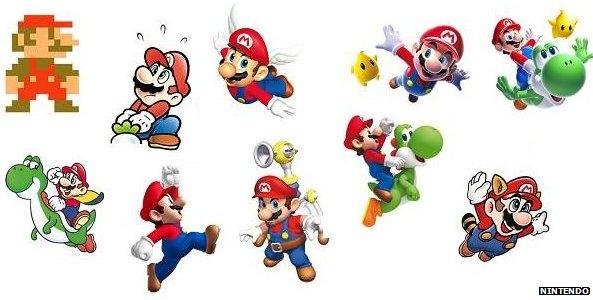
The graphics may have improved, but Mario is still recognisable from how he appeared in his earliest 1980s adventures
Mario isn't your typical type of hero. He clearly doesn't pump iron, he wears overalls rather than a tight-fitting body suit, and is still rocking a 1980s-style thick moustache.
But the little Italian plumber from Brooklyn is set to be the highlight of his Japanese parent's press conference at the world's biggest video games trade show this week.
Nintendo is expected to announce a new Super Mario game for its upcoming Wii U console, as well as provide more details about at least two titles featuring the character for its 3DS handheld games machine.
The revelations at the E3 event in Los Angeles will mark the latest evolution of the company's 31-year-old mascot.
Mario originally started life as Jumpman, a carpenter with a blue shirt and red overalls whose girlfriend was kidnapped in the game Donkey Kong.
He was renamed Mario by his creator Shigeru Miyamoto ahead of the sequel Donkey Kong Jr's launch in the US - a rare instance in which he portrayed the villain.
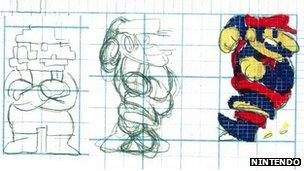
Early designs for Mario were limited by the graphics capabilities of 1980s video arcade machines
Legend has it he was named after Mario Segale, landlord of a US warehouse rented by the firm.
Mario art
He has since appeared in more than 200 games, including educational titles, sports simulations and, most famously, in a series of side-scrolling platformers alongside his brother Luigi.
But Mario's influence extends far beyond his video game cartridges, making him an unlikely cultural icon.
Tim Augst, a 24-year-old living in Melbourne, set up a website in 2006 to document all things Mario.
Mario Mayhem currently receives about 100,000 unique visits a month, with a cross-section of individuals contacting him to pay homage.
"I get a lot of younger kids sending in their Mario drawings and other kinds of art, and then I get the older kids, and even 30-year-old adults, sending in everything from videos to pictures of their tattoos," Mr Augst says.
"There are probably a few more guys contacting me than girls, but not by much."
Name change
The Australian curator and his visitors aren't the only ones with a Mario obsession. Some take it to a deeper level.
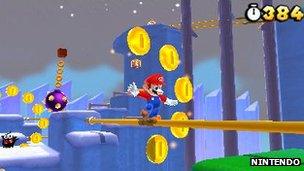
Super Mario 3D Land is one of the best-selling games for Nintendo's latest handheld console
'"Except for cartoons, Mario was my only escape from the problems at home," Mario Brotha, a New York-based contemporary artist, tells the BBC.
Mr Brotha says changing his name to echo Nintendo's protagonist has helped attract attention, giving him a competitive advantage when it comes to winning commissions for magazine fashion shoots and advertising campaigns.
"I remember racing home from school everyday just to be Mario for a couple hours. Mario Bros was my first experience with the digital-electronic world. So I chose Mario Brotha as a name to represent how far technology has come in the last 20 years."
The character also proved influential to one of the men behind another hit video game series.
"Mario is a great character," says Peter Vesterbacka, the chief marketing officer - or "mighty eagle" - at Angry Birds' developer Rovio.
"But it's not just about him - it's the whole world that Nintendo has built, with the other great characters and the stories told through its games.
"Like Angry Birds, it's a game that both kids and parents can enjoy, and a great example of how games can connect generations."
Block buster
Mario's original design was the result of technological limitations.
He was given a big nose and moustache because early video games' graphics were limited to blocky pixels.
He has a hat as Mr Miyamoto was not a fan of drawing hair, and the colours red and blue were selected to help him stand out from the background.
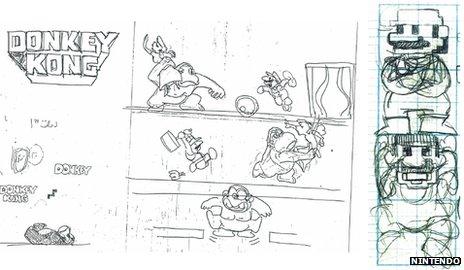
Mario had to rescue his girlfriend from an ape in Donkey Kong, but in the sequel he became the villain from whom the gorilla had to be rescued
Since then, little details have been added, such as buttons and the logo on his cap.
"As far as things go, there isn't a lot of depth to him," says Professor Jose Zagal, a game designer and academic at DePaul University, Chicago.
"He's defined by a few traits and characteristics: Italian-American, a bit tubby, sports a moustache, and is cheerful and brave. That's about it really."
Despite his appearance it would be foolish to underestimate Mario's power, says Ed Barton, director of digital media at Strategy Analytics.
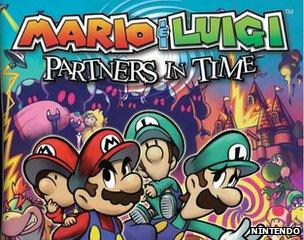
Mario and his brother have appeared in several time travel titles, once meeting themselves as babies
"He is the most iconic video games character - Super Mario is to games what Mickey Mouse is to cartoons," he says.
"Nintendo has been very careful with the intellectual property he represents, keeping the quality of his games not just high but industry-defining.
"Super Mario games are a benchmark for all platforming games."
So how much is the little guy worth?
"A quick back of the envelope calculation comes to around 250 million unit sales, which even with a conservative average sales price comes out at around $10bn (£6.5bn) in new games sales," says Mr Barton.
"Obviously the series has generated more through second-hand games sales and licensing."
Smartphone boycott
Mario shouldn't need to worry that he will ever have to go back to unblocking drains. But there are some clouds over his future.
Nintendo posted a net loss of 43.2bn yen ($553m, £360m) over its last financial year, and some question the firm's refusal to release Mario games on iPhones and Android handsets.
"Smartphones are already the biggest device category, but gaming will be on all connected screens," says Mr Vesterbacka.

New Super Mario Bros Wii helped drive sales of Nintendo's last console
Prof Zagal suggests the character's fate may depend on the success of Nintendo's hardware.
"While Nintendo's 3DS sales have picked up, it got off to a rocky start and the upcoming Wii U console seems to have created more confusion than excitement," he says.
"On the other hand, Nintendo's Wii was met with great derision when it first launched but ended up soundly trouncing everyone else in terms of sales numbers."
But one thing the experts and fans are resolute about is that Mario should keep at his most lucrative activity.
"Princess saving is what he seems to do most often and most successfully," states Prof Zagal.
But Mr Augst says he wishes he could ask his hero one question: "Is Princess Peach really worth it?"
- Published4 June 2012
- Published30 May 2012
- Published27 April 2012
- Published26 April 2012